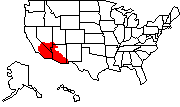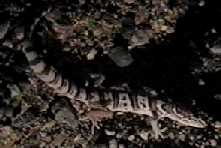|
Utah Banded Gecko
|
- Order: Squamata (scaled reptiles)
- Suborder: Lacertilia (=Sauria; lizards)
- Family: Gekkonidae (geckos)
- Subfamily: Eublepharinae (geckos with eyelids)
- Genus: Coleonyx (banded geckos)
|
| Also known as: Western
banded gecko (generic name for all subspecies of Coleonyx
variegatus) |
Scientific Name: Coleonyx
variegatus utahensis Klauber, 1945 |
| Habitat: Rocky areas,
cliffs, washes, and dunes. |
Koleos="covered," onyx="claw,"
variegatus="of different colors," utahensis="from
Utah"
|
| Length: to 6 inches
total. |
|
| Food: Small insects
and spiders. |
 |
|
Banded geckos are one of the few types of lizards
you will see at night. Most desert lizards are active during the
day, but geckos and night lizards (Xantusia) are nocturnal.
These lizards are most often encountered on the roads at night.
They utilize the heat of the roads to warm themselves before
searching for food. Geckos are unique in that they can
vocalize--while some tropical species can bark loudly, the most
that banded geckos can muster are small chirps and squeaks. |
|
| When I saw my first gecko it was
crossing the road slowly with its tail arched over its back. The
first thing I thought was that it looked a lot like a scorpion,
which leads me to believe this may be a form of mimicry to ward
off potential predators. |
 |
| The picture here is a different
gecko found the following night on an interstate on-ramp just
outside Mojave
National Preserve in California. It was pretty big for a
banded gecko, probably six inches long. It was a cold night with
mist and intermittent showers, but the geckos were still active. I
found more specimens on another occasion when the air temperature
was 60 degrees Fahrenheit. |
|
|
|
|
|
|